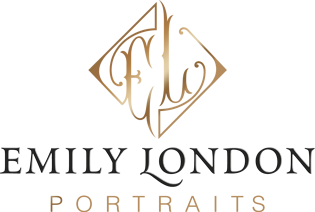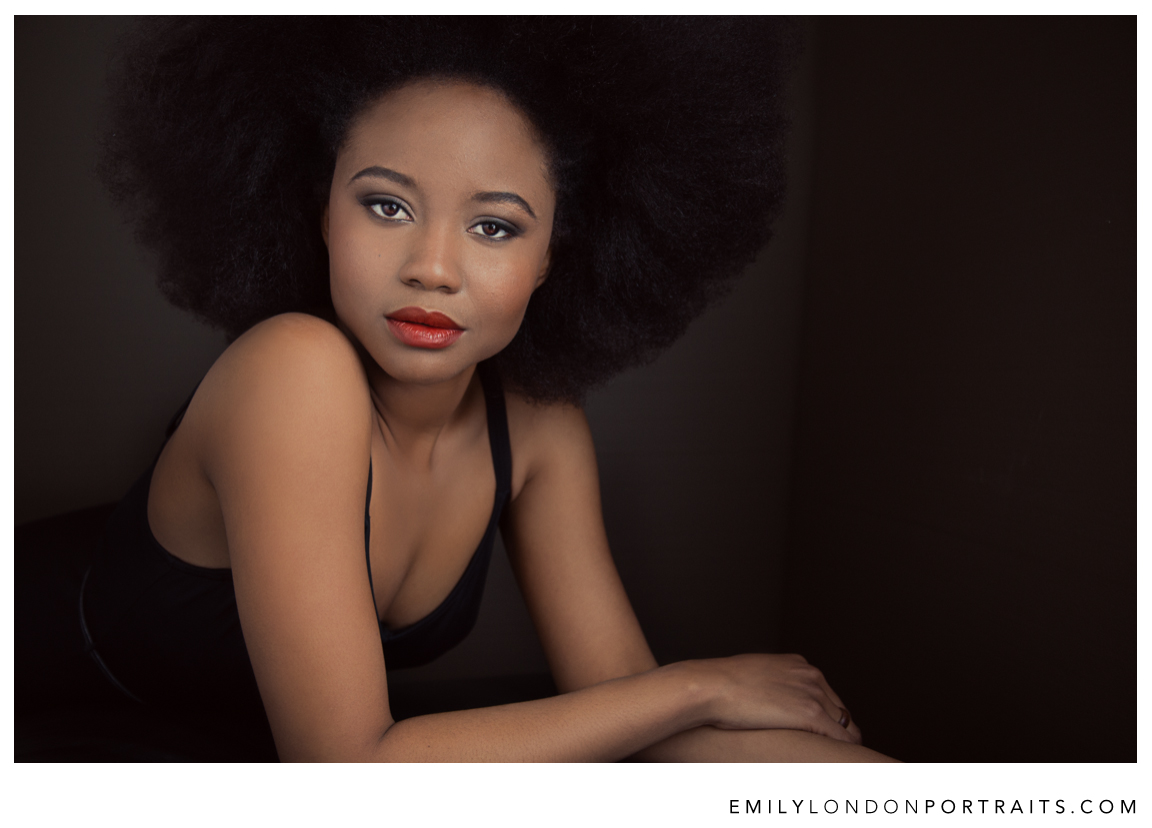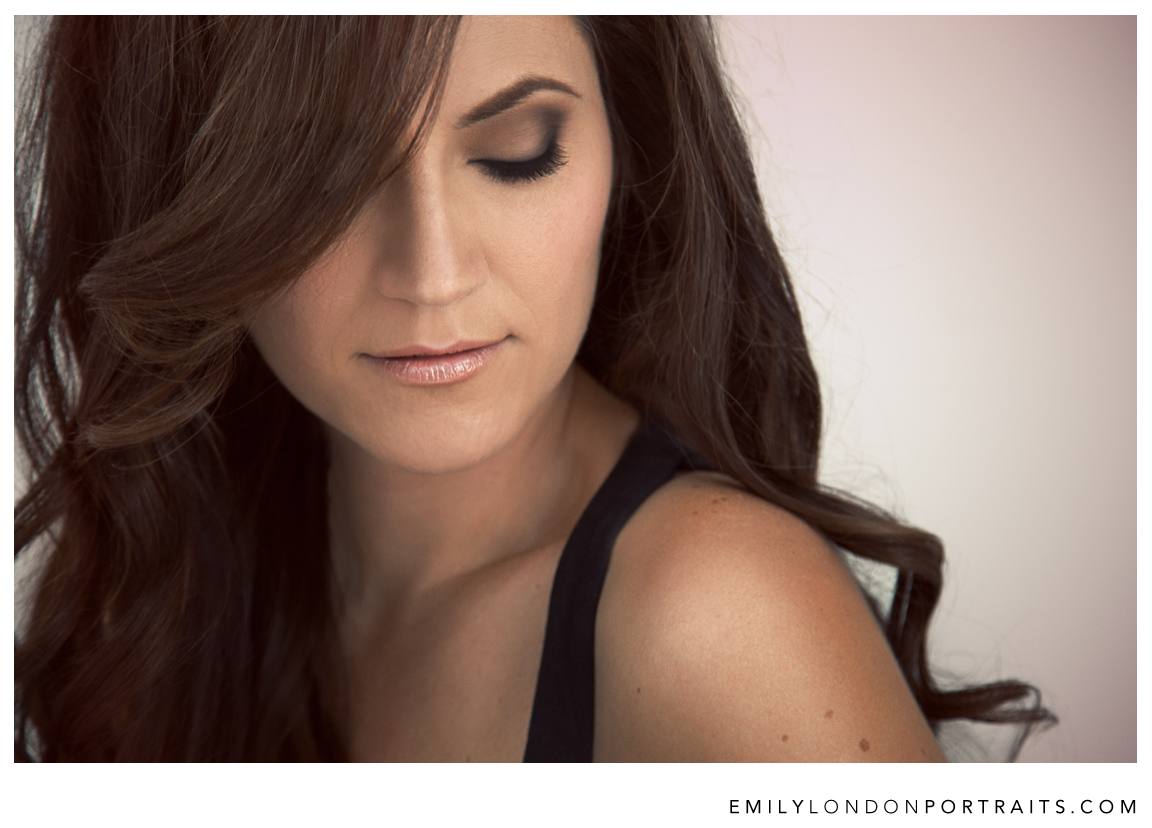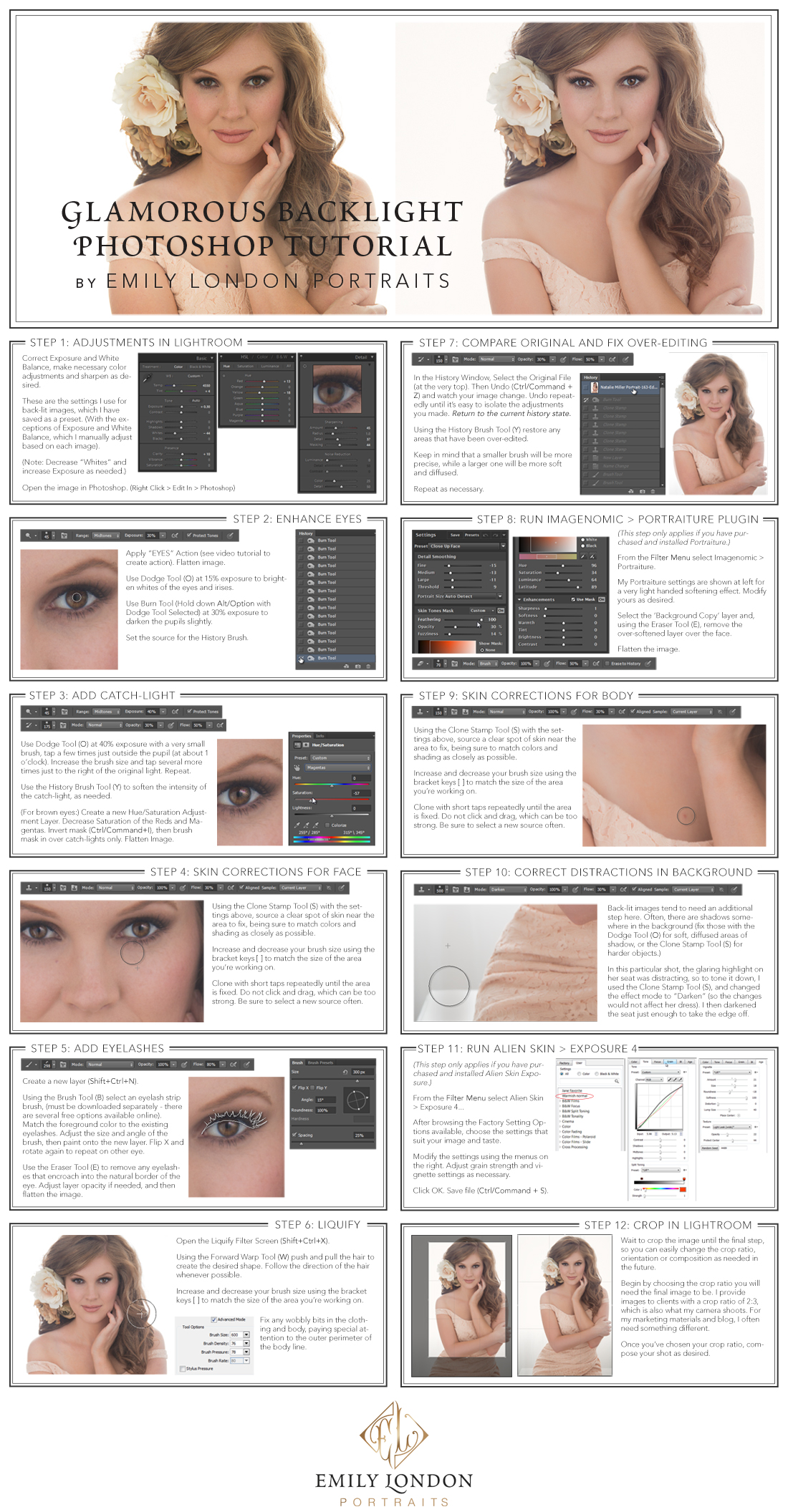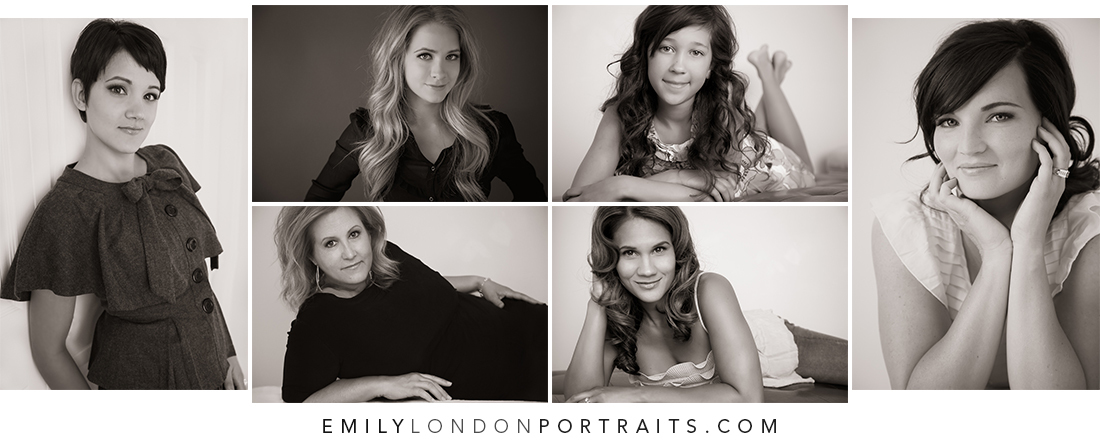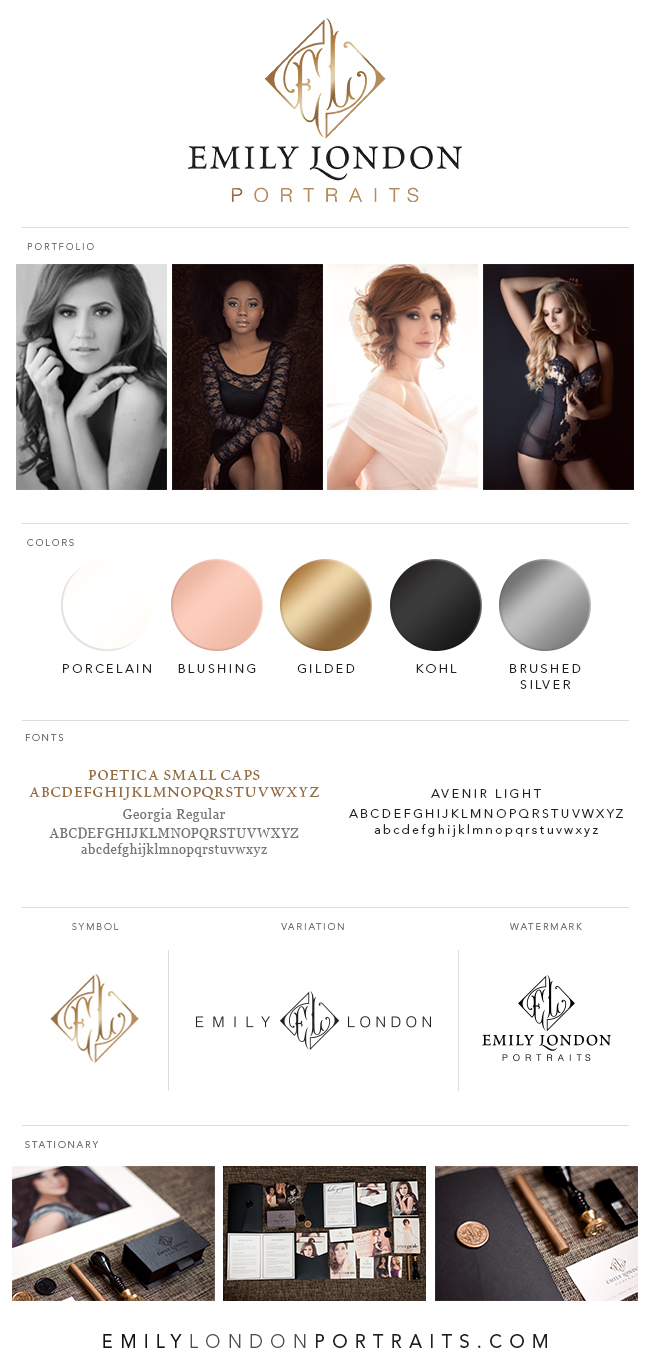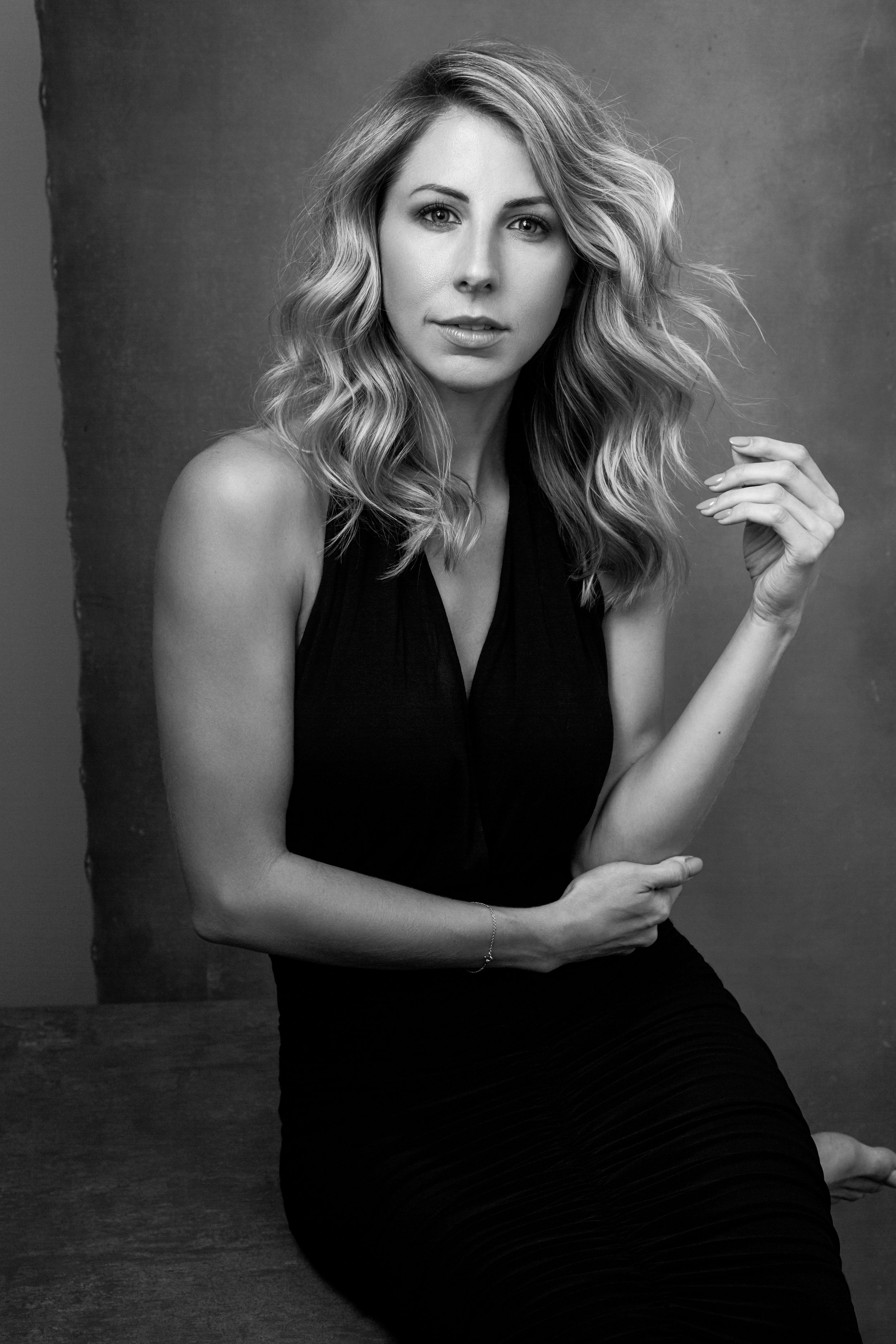Incredible hair and makeup is one of the most important parts of a photoshoot with Emily London Portraits. While the aesthetic benefits are obvious, one of the hidden perks is the role it plays in your confidence. When you feel beautiful - with gorgeous hair and incredible makeup - you can forget about that part of yourself and reveal the inner sparkle that shines through your eyes as you smile, laugh, and connect with me through my lens.
Every shoot in the studio includes professional makeup and hair styling by brilliant artists hand-picked for their exceptional talent and understanding of the particular requirements for natural light photography.
Because I've been so fortunate to work with such gifted artists, I'm often asked by fellow photographers:
- where to find makeup artists
- how to know if they're damn good
- how to communicate your needs to them
- how much to pay them
- how to build up a database of reliable, talented makeup artists that you can depend on
If you are a photographer on the hunt for incredible makeup artists, or interested in seeing how I dealt with all these questions in my own makeup artist search efforts, this is the first of a two-post series on Building A Makeup Artist Database. Today I'll be offering ideas about finding incredible makeup artists, tomorrow we'll talk about how much to pay them and how to work with them to produce amazing results.
Check Your Local Laws and Requirements
Before you begin your own Hair Stylist/Makeup Artist hunt, research your local laws regarding licencing for hair and makeup. Each state has different requirements. In some states, makeup artists must be licensed to apply makeup in any situation. Some will allow makeup to be applied by a non-licensed artist only if the client is not paying for the service. Some have different rules relating to the film and photography industries. Hair styling laws are generally more strict, but often have various loopholes. For example, if hair will be styled only (no cutting or chemical processing), a non-licensed stylist might be okay for your needs.
Once you find out what your own state's regulations are, you can then be sure to work within whatever limitations you may have, and don't even interview candidates without the necessary certification.
Makeup Artist, Hairstylist, or Two-in-One?
I always like to work with makeup artists who are also hairstylists. This simplifies scheduling, and keeps drama to a minimum. It isn't the only way to go, though. If you hire separate people for hair and makeup, you have the benefit of extra helping hands during the shoot, and you'll be able to choose from a wider pool of candidates. Finding an excellent hair stylist who is also a makeup artist can be a challenge, but the benefits are worth the effort. Don't expect your search to be over in a day. I'm still on the hunt for talented people to add to my team, and I can't imagine that I'll ever stop.
I try to work with each H/MUA (Hair / Make Up Artist) individually, as opposed to with an agency or through a salon. While there are benefits to working with an agency, they usually come with a much higher price tag.
How Many Makeup Artists Do You Need?
This number will depend on how often you need to hire a makeup artist, how busy your makeup artists are, and how many artists are your 'top choices' vs 'backups.' I do one-two shoots per week, and my own database has two excellent H/MUAs as well as five backups. (If you are hiring separate MUAs and Hairstylists, you'll want a separate database for each.)
My top artists are like magical fairies dusting awesome-sauce all over my studio, and I'm pretty loyal to them, bringing them as much business as they'd like. Once they start getting busy enough to regularly turn my work away, my database will need to increase. I am often testing with new H/MUAs in an effort to polish my database and find artists who are a perfect fit in my studio, but I am very particular, so it's fairly uncommon for me to add a new artist to the regular rotation.
Where to Find Makeup Artists
The first place I started looking for makeup artists was online. I did a Google search for "Utah Makeup Artist", and also checked out an online Makeup Artist Directory. Facebook and Model Mayhem are also good online resources for finding MUAs.
There are several great places to find makeup artists locally. Try visiting a few cosmetic counters at different department stores. Check out any local cosmetology schools, and consider both students and teachers as potential makeup artists for your database. Many hair salons and spas will have a makeup artist or two, possibly working as a hairstylist. Many hairstylists can do makeup, or will know at least one pro makeup artist.
How to Book a Test Shoot
When you meet an MUA in person (possibly at a salon, makeup counter, or hair school) be prepared to show your portfolio. Bring your iPad or even show a gallery on your smart phone. If you're just starting out, at least show examples of the style you're interested in creating. Explain what you do (or want to do) for each shoot, mention how often you plan on hiring an MUA, and see if they have any interest in the opportunity.
If you're making your first contact online, send an email with all the points mentioned above. When I started searching for MUAs, I sent this email to dozens of makeup artists who were within an hour of my studio:
“My name is Emily, and I’m a modern glamour photographer based in Provo, specializing in magazine-style portraits. I am looking to establish a relationship with a local MUA who can do hair and makeup on a range of clients, in keeping with my personal aesthetic, while also keeping my clients happy.
I schedule 1-2 double shoots per week, (two clients come in at the same time, usually a mom/daughter, sisters, or friends; for a girls-day-out makeover and photo shoot). The styling begins at 8:30am in my home studio in Provo, and is usually on Tues, Thurs, and Fri, as well as a couple Saturdays a month.
I have a makeup area with good lighting and table space, and can provide all the makeup products needed for the shoot (though you would be welcome to bring your own products as you like). I will also give a beautiful image of each client for your portfolio.
I would like to know the pricing you would charge me for each session, and also to schedule a test-run.”
Be as clear as possible about your offer (consistent work, beautiful images for their portfolio, and monetary compensation), your location, your expectations, and any other logistics that may be helpful. End by suggesting that the next step toward working together is booking a test-run. For the test shoot, the MUA can either work on me, a model of my choice, or bring her own model, and I usually let the MUA decide.
Never try out a new MUA on a real client - believe me when I say that every time I have, it turned out to be a mistake. The whole purpose of having an MUA Database is that you should never find yourself without a trusted makeup artist to work with.
Test-Shoot Logistics
Time Breakdown
Schedule two hours for a test shoot. You'll need time to explain your specific needs to the makeup artist before she can begin, and be very clear that the hair and makeup process should take no more than an hour (an extra 30 minutes for clients with long and/or thick hair would be appropriate). Plan at least 10 minutes to photograph the final look, and about a half hour (if the test goes well) to discuss the details of working together in the future.
Model Expectations
The model needs to be educated by you or the makeup artist beforehand, so she knows to arrive with clean, moisturized skin, touched-up eyebrows, and clean, dry hair. I usually suggest she wear something comfortable, but bring a beautiful dress or blouse to be photographed in. She should also be informed that I'll be providing the digital file of my favorite image to her and the MUA as well. Be sure to deliver said image within 24 hours.
Location Specs
Provide a well lit space for styling to take place, with counter space, a comfortable chair, (preferably one that can be raised and lowered, or even a tall chair and a low chair) and a mirror. You'll also need to have several outlets nearby for a curling iron and blow dryer. Bonus point for having an extension cord handy. I also have a full makeup kit with my preferred products, but a pro makeup artist will bring her own kit.
Clear Styling Direction
When explaining styling to a new MUA, I'll have several images (on my ipad or computer) to show examples of my various needs. Your own requirements may be different than mine, but should be no less clear and specific when described to your makeup artist.
What are my makeup rules? I never allow shimmer or glitter in any products, even eye shadow, highlighter, or lip gloss. Skin should have a matte finish, skipping contouring under the cheekbones. I also am very specific on the way eye shadow should look (matte and very well blended), as well as eye liner (black, and right at the base of the upper lash-line, sometimes called "tight-lined"). Eyebrows should nearly match the model's hair, be filled in, and symmetric. Hair should be curled and very voluminous.
(Over time, I plan to add several posts and videos that illustrate each of these very specific needs. The posts will include both how to describe them to MUAs, and how to fix them with Photoshop if the MUA does not achieve the correct look. Subscribe below to see these posts as soon as they're released.)
Take Photos
Take a 'Before' photo when the model arrives, and have her sign a model release. When styling is complete, take several shots in your typical studio space. I am a natural light shooter, so I prefer to book test run shoots in the morning, which will allow the best light in my space. I also have a couple of soft-boxes so if an evening shoot is more convenient, I can make that work as well.
When everybody leaves, I'll fully edit the best photo immediately, and post it to my photography Facebook page (as a watermarked PNG), and tag the Model and MUA, or ask them to tag themselves. Then I send it (along with the 'before' shot) via email to both the model and MUA. (usually as a 7x10 JPG at 300dpi).
What to Look For During the Test-Run
Reliability
Does the MUA arrive on time? A great MUA should be 15 minutes early. If she is late, do not hire her. She's showing you that she can't be relied on. Believe her. (It's your call if you'd like to even finish the test run.)
Cleanliness
Watch out for important makeup hygiene. Does she wash her hands? Are her makeup brushes clean? Is her kit neat? Does she use disposable mascara and lipgloss wands? Does she ever double-dip them? Are her hair brushes sanitized and hair-free? Feel free to ask her about her sanitation practices. Saying, "What exactly do you do to keep the whole process sanitary?" is a great way to gauge her hygiene knowledge. (Her habits, on the other hand, are something you'll have to keep an eye on during the test.)
Speed
Be sure to point out that speed is important to you, and will be a factor in whether you can hire her for photoshoots. Set a timer in front of her, and leave it where she can see how much time she has taken. If the styling takes more than the hour allotted, she might not be fast enough for this kind of shoot. (Most non-model clients won't have much energy left for the actual photoshoot after a couple of hours in the makeup chair.)
Personality/Energy
Is the MUA a pleasure to be around? Does she put the model at ease? Can she work efficiently while being friendly, or does she pause often to chat? Does she complain or gossip? Can she handle taking your direction well? The last thing you need is any drama in your studio. Find somebody who you enjoy spending time with, since you will potentially see her often.
Fragrance
Does her breath smell? Does she have body odor? Is her perfume over-powering? Bad breath is probably the most likely offender, and also really unpleasant for the model. Good makeup artists are aware of their breath, and usually carry gum or mints to help with this. If she doesn't, and you decide to work with her in the future, you might need to have a mildly uncomfortable conversation about her breath. If she's excellent, it will be worth it. (Please don't just ignore it, and subject client-after-client to an uncomfortable situation.)
Gentle Touch
Does she have a harsh touch, use brushes that are rough or painful, or clamp her free hand on your head? Having your makeup applied by a professional should be soothing, similar to a spa treatment.
Staying Power
Does the hair style go limp before the test shoot is finished? Does the eye shadow start creasing? Certain touch ups are inevitable - but if the model starts wilting within an hour, your MUA might be using the wrong products, or not asking your model the right questions.
Aesthetics
While all the other factors mentioned above are important, they really mean nothing if this area is not up to par. Do you like the way the hair and makeup looks when all is said and done? Has she followed your artistic direction? Does it look better than you could do it yourself? Does it look magazine quality? Does your model like it?
Taking a photo (or several) of the model will give you the chance to really study the makeup on your screen, and to see how well it photographs. Look for asymmetry in the features of the client, and if the makeup improved it or exaggerated it. If you decide to work with the MUA in the future, show her the photograph without any editing, as well as the final edit. This way she can see what you changed with photoshop, and work toward decreasing the amount of post-processing needed with each shoot you have together.
If your own makeup knowledge is limited, show the images to a friend who's makeup you admire, and ask for her honest opinion. If you ask specific questions, (Do you like the lipstick color? Is the foundation a good match? Does her skin look even? Is the eye shadow color/placement lovely? Does her eyeliner look great? What about her mascara/fake eyelashes?) you'll get a great lesson on what you could change in photoshop, as well as what your MUA might do differently.
Price Vs. Quality
Is the price she's asking worth the quality of the final results? If she's out of your current budget, but you love her work, you might add her to your database for 'someday' or 'just in case.' If her prices work for you, but her skills are less than stellar, you have to decide if she's good enough to be on your list (possibly as a 'back-up' artist).
Speaking of Price - tomorrow's post will begin by breaking down what you can expect to pay a high-quality makeup artist. I'll also hash-out how to talk pricing with your artists, we'll go over the best practices for working as a well-oiled team, and finally, how to keep great artists once you've found them.
